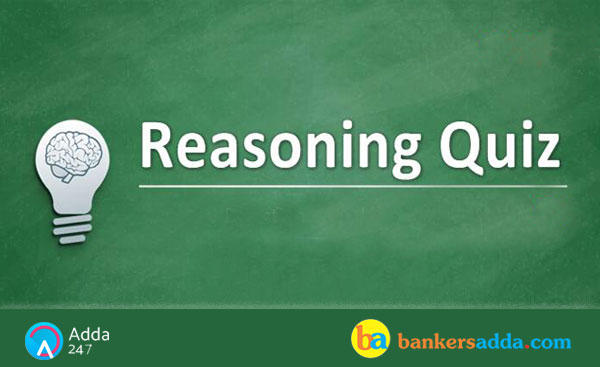Dear Aspirants,
Reasoning Ability is an onerous section. With the increasing complexity of questions, it becomes hard for one to give it the cold shoulder. The only way to make the grade in this particular section in the forthcoming banking exams is to practice continuously with all your heart and soul. And, to let you practice with the best of the latest pattern questions, here is the Adda247 Reasoning Quiz based on the exact same pattern of questions that are being asked in the exams.
Directions (1-5): Read the following information carefully and answer the questions that follow.
Ten persons are sitting in two parallel rows containing five persons in each. In row 1, P, Q R, S and T are sitting and all of them are facing south. In row 2, A, B, C, D and E are sitting and all of them are facing north. In the given seating arrangement, each person seated in a row faces another person of the other row but not necessarily in the same order. Each of them likes different singer viz. Sherya, Sonu, Lata, Asha, Sunidhi, Arjit, Tulsi, Alka, Alisha and Neeti but not necessarily in the same order.
There are two persons sit between the one who likes Sherya who sits at an extreme end and T. A sits middle of the row and not an immediate neighbour of B who does not like Neeti. E is sitting at an extreme end of the row. T likes Sunidhi and sits on the immediate right of the one who likes Sonu . T faces the immediate neighhour of B. R does not sit at the extreme left end of the row. A does not like Alisha. There is only one person sits between Q and S who likes Sherya. D likes Arjit and is an immediate neighbour of the one likes who likes Neeti. D does not face the one who like Lata. C likes Asha and is an immediate neighbour of the one who like Alisha. The one who likes Alisha faces the immediate neighbour of the one who likes Sunidhi. There are two persons sit between the one who likes Tulsi and the one who likes Lata. R does not like Tulsi. E does not like Alka.
Q1. Who among following sit at the extreme end of the line?
(a) R,C
(b) S,A
(c) Q,B
(d) E,T
(e) B,S
Q2. Who sits second to right of T?
(a) The one who likes Sherya
(b)No one.
(c) The one who likes Tulsi.
(d) The one who likes Alisha.
(e) The one who likes Lata
Q3.Who among the following sits diagonally opposite to R?
(a) E who likes Neeti
(b) D who likes Arjit
(c) A who likes Asha
(d) E who likes Alisha
(e) None of these
Q4. Four of the following five are alike in a certain way based on their seating positions and so form a group. Which of the following is different from the group?
(a) T
(b) R
(c) S
(d) B
(e) E
Q5. Which of the following is/are definitely false?
(a) P-Tulsi
(b) E-Neeti
(c) T-Sunidhi
(d) C-Asha
(e) All are true
Directions (6-10): In the following questions, the symbols $, #, @, % and * are used with the following meanings illustrated:
‘A $ B’ means ‘A is not smaller than B’.
‘A # B’ means ‘A is neither greater than nor equal to B’.
‘A @ B’ means ‘A is neither smaller than nor equal to B’.
‘A % B’ means ‘A is not greater than B’.
‘A * B’ means ‘A is neither greater than nor smaller than B’.
In each of the following questions, assuming the given statements to be true, find out which of the three conclusions I, II and III given below them is/are definitely true and indicate your answer accordingly.
Q6. Statements: D * Q, Q @ L, L $ B, B # G
Conclusions:
I. D @ B
II. B * D
III. G @ L
(a) Either I or II only
(b) I and III only
(c) II only
(d) II and III only
(e) None of these
Q7. Statements: Z @ Y, Y # K, K % M, M @ T
Conclusions:
I. Z @ M
II. Y @ T
III. Z # K
(a) I only
(b) II and III only
(c) Either I or III only
(d) All I, II and III
(e) None is true
Q8. Statements: P # M, M % R, R * T, T # L
Conclusions:
I. P # R
II. P * R
III. M % L
(a) I and II only
(b) Either I or II only
(c) III only
(d) All I, II and III
(e) None of these
Q9. Statements: F @ H, M % H, M $ R, G * M
Conclusions:
I. F $ R
II. F @ R
III. H $ G
(a) II and III only
(b) II only
(c) III only
(d) III and either I or II
(e) None of these
Q10. Statements: K @ T, T # D, D * F, F % G
Conclusions:
I. G @ K
II. G * T
III. G @ T
(a) I and II only
(b) II and III only
(c) Either II or III only
(d) III only
(e) None of these
Directions (11-15): Each of the questions below consist of a question and two statements numbered I and II given below it. You have to decide whether the data provided in the statements are sufficient to answer the question. Read both the statements and give answer
(a) if the data in statement I alone are sufficient to answer the question, while the data in statement II alone are not sufficient to answer the question.
(b) if the data in statement II alone are sufficient to answer the question, while the data in statement I alone are not sufficient to answer the question.
(c) if the data either in statement I alone or in statement II alone are sufficient to answer the question.
(d) if the data in both statement I and II together are not sufficient to answer the question.
(e) if the data in both statement I and II together are necessary to answer the question.
Q11. Which word in the code language means ‘flower’?
I. ‘dem fu la pane’ means ‘rose flower is beautiful’ and ‘la quiz’ means ‘beautiful tree’.
II. ‘dem fu chin’ means ‘red rose flower’ and ‘pa chin’ means ‘red tea’.
Q12. How many daughters does M have?
I. P and Q are the only daughters of N.
II. D is brother of P and son of M.
Q13. How is P related to M?
I. P is brother of K and T.
II. T is daughter of Q and sister of M’s daughter.
Q14. On which day of week did Mohan reach Delhi?
I. Mohan left Mumbai by train on Tuesday.
II. Mohan stayed for one day in Jaipur and completed his journey to Delhi in two days.
Q15. Who earns the highest among five friends?
I. Priya earns more than Pinky, Nia, and Sheetal but less than only Shilpa.
II. Sheetal earns more than Neetu but less than Pinky.








